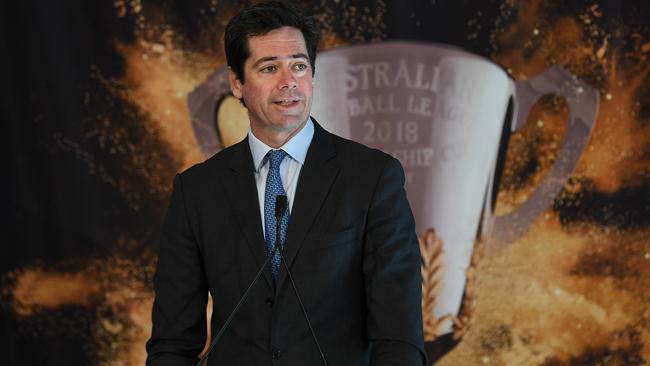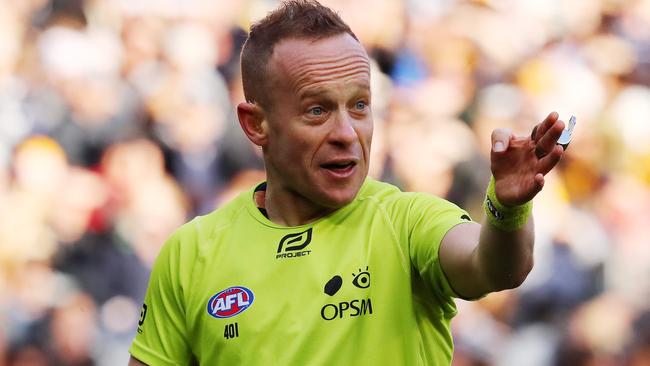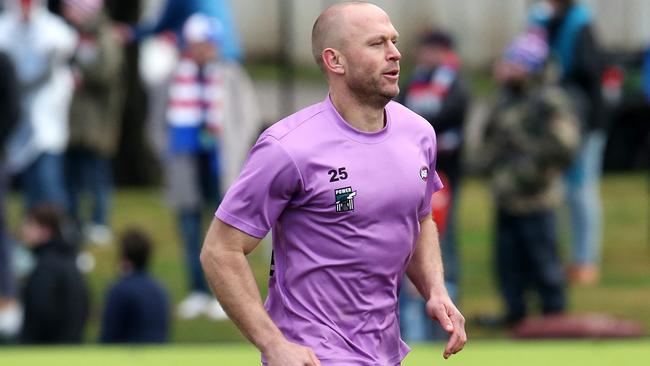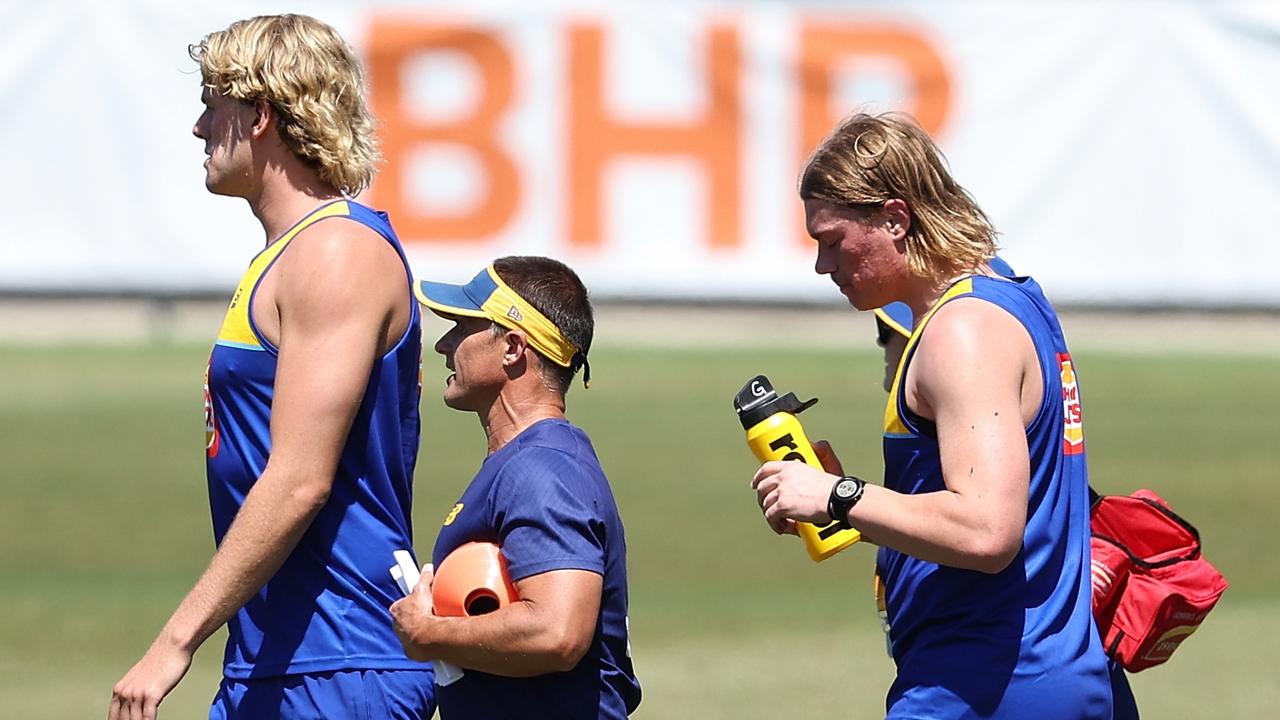AFL announces there will be nine rule changes for the 2019 season
RULE changes dominated the headlines throughout the season. Now we finally know exactly how the game will look next year. JON RALPH reviews the nine new rules.

AFL News
Don't miss out on the headlines from AFL News. Followed categories will be added to My News.
THE AFL says kick-in strategies will be “revolutionised” with a new more flexible goal square as part of changes that also bring power forwards and ruckmen back into the game.
On Thursday, the league brought in nine new rules and interpretations to help lift scoring, pulling back on dramatic interventionist policies it looked likely to introduce mid-year.
The most contentious is allowing full-backs to run straight out of the goal square without kicking the ball to themselves, freeing them up to take on the man on the mark or boot the ball long.
BUCKY: WHICH PIES WILL BE THE DIFFERENCE?
BUCKY: DO THE DEES REALLY NEED MAY?
BUCKY: SAINTS MUST PUSH ON WITH CLEAN OUT
As revealed by the Herald Sun, the AFL decided against an 18m goal square but instead put in place rules which encouraged longer kick-ins.
As the AFL’s tactical guru David Rath said: “This could revolutionise kick-in strategy.”
But wingmen such as Andrew Gaff and Jared Polec, ruckmen such as Max Gawn and Brodie Grundy and key forwards such as Tom Hawkins should also capitalise on the new rules.

A 6-6-6 set-up at centre bounces means only wingmen can patrol the edge of the centre square at bounces as six players per team are forced to start inside 50m, one of them in the goal square.
Teams can only drop players back after the bounce, which could lead to more blowouts.
But AFL football operations boss Steve Hocking said it provided a better balance of defence and offence, with the league this year having recorded the lowest scores since 1968.
Teams will no longer be able to drop multiple players back to defend a lead in the final frantic minutes.
“This can be more exciting, too. If your team is down they can take the game on,” said Hocking.
Sorry @ClaytonOliver16 I’m grabbing it from now https://t.co/wVN4meJWPe
— Max Gawn (@gawndog37) October 11, 2018
So the AFL have just had one of the best Grand Finals in the last decade and now they decide to change the rules.. 🤔🤔
— Cameron Rayner (@ramcayner) October 11, 2018
Looks like I will be fighting you for the kick ins @alexwitherden29 https://t.co/oXHnXYWXVX
— Luke Hodge (@LHodge15) October 11, 2018
“As clubs do, they will innovate. It changes the landscape and it’s pretty exciting to see how it unfolds.”
He denied there would be a backlash, as players including Cam Rayner tweeted their opposition to any changes after such a brilliant Grand Final.
Hocking conceded the Grand Final was a perfect exhibition of football with valuable roles played by rucks and power forwards.
But he believes these changes will bring attack back into the game.
He said coaches were thrilled with a rule that abolished the 2006 hands-in-the-back penalty, allowing players to protect space with their hands as long as they didn’t shove opponents out of the action.

“The coaches are pretty excited about this one. Push in the back is still a rule but we want to see players playing on instinct.We believe this improves the game,” Hocking said.
The death of the second ruckman in football might be reversed by a new rule which allows the big men to take the ball out of the ruck without losing prior opportunities.
Clubs had at times stopped contesting ball-ups around the ground or thrown in an undersized ruckman, knowing stars such as Max Gawn could not maximise their height advantage.
Now their ability to take the ball directly out of the ruck will mean teams will likely again play two rucks.
Hocking reinforced the AFL’s charter to allow players of all shapes and sizes in football.
“We don’t want this feature out of our game,” he said.
“Just to see these big men in our game, what does this do for Max Gawn, Brodie Grundy and Ben McEvoy.”
Runners and water carriers are now banned for all but 45 seconds after a goal and players will no longer be able to set up behind umpires at centre bounces.

JON RALPH ON THE AFL’S NINE RULES CHANGES
Rule 1: Players no longer have to kick the ball to themselves from full-back to play on. As soon as the goal umpire signals a behind they can run out of the goal square then kick or handball. The player on the mark is 10m back from the top of the goalsquare.
What it means: The AFL believes this can be a game-changer, allowing quick players with great skills such as Lachie Whitfield to attack from full-back with unpredictability and intent.
Ralphy’s verdict: Brilliant. The 18m goalsquare just looked wrong, but this adds another element of excitement, allows new tactics and should mean higher scores.
Rule 2: A 6-6-6 centre square set-up with six players from each side inside 50m at each centre square, including one in each goal square. Wingman can patrol up and down each side of the centre square but not drop behind the ball.
What it means: For a few seconds after every bounce there is more space for pure clearances, but there is no more flooding the backline to preserve a last-minute lead.
Ralphy’s verdict: Wingman become critical given their room to move. But the first time a club loses a game with a last-second goal they couldn’t defend with numbers back the coaches will go mad.
Rule 3: No more water carriers or runners on the ground during play. They have 45 seconds after a goal to do their thing and get off the ground.
What it means: No more on-ground coaching from runners.
Ralphy’s verdict: A no-brainer. Reduces cluttering on the ground. As Steve Hocking said, “it’s about the game, not the people in pink”.
Rule 4: The hands in the back rule is repealed, meaning a player can put his hands in the back of an opponent but not push them.
What it means: The AFL wants a return to the days of power forwards, so they can hold their space and protect the drop zone but not shove opponents out.
Ralphy’s verdict: Sounds good in principle but we might return to the old grey areas where no one knew who was protecting space and who was pushing players out.
Rule 5: A ruckman who takes possession of the ball at a bounce or throw-up doesn’t lose their prior opportunity but the old ruck nominations remain.
What it means: Al Clarkson gets his way as the rucks return to prominence. If a team doesn’t contest a stoppage or sends in a midfielder such as Shaun Grigg, it hands the advantage to a Max Gawn or Brodie Grundy type.
Ralphy’s verdict: A cracker. Ruckmen will become even more instrumental in matches, allowing them to dominate against a part-time ruck opponent.
Rule 6. Players are no longer allowed to set up behind the umpire at centre bounces.
What it means: Steve Hocking is sick of players running into umpires, so if they set up behind them they can expect even bigger fines.
Ralphy’s verdict: Fair enough. It’s pretty simple, just don’t set up there and you can’t complain about being fined.
Rule 7: A player awarded a mark post-siren can now kick a snap shot at goal but they must kick over the man on the mark. For instance, a right-footer must set up five metres left of the mark then kick the ball as they reach the line that runs between the goal and the man on the mark, and not after.
What it means: The AFL believes it must respond to footy’s evolution, allowing room for the snap-shot or checkside even after the siren.
Ralphy’s verdict: Stevie J’s influence grows, but it will be hard to judge exactly when a player runs over that line and an umpire calls play on to allow rival players to rush in.
Rule 8: If a defender marks or is awarded a free kick deep in defence next to the point post, the man on the mark must retreat in line with the top of the goal square.
What it means: Another rule to allow teams to spirit the ball from defence, given they are often hemmed in and don’t even have room to kick a long bomb down the line.
Ralphy’s verdict: Won’t have a huge impact on the whole but at least allows defenders room to play on laterally.
Rule 9: When a player wins a 50m penalty the umpire will be stricter on the infringing player, not allowing him to delay his opponent rushing upfield to quickly take his kick. The advancing player can play on any time as he moves up field to get to the forward point of the 50m penalty.
What it means: The AFL says too often the defending team delays and holds up the player rushing up field. Now there will be a rolling exclusion zone which means he can break into space or play on any time if he spots a free man upfield without a group of players around him.
Ralphy’s verdict: A real potential for coaches to go troppo the first time a player gives away repeat 50m penalties which costs them a goal, or a game. But in principle the 50m penalty should be a massive deterrent but it isn’t because the defensive team holds up play so effectively.


